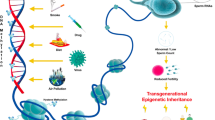Purpose
Diploidy in embryos developing from single pronucleated zygotes can occur following parthenogenetic activation or by asynchronous inflation of pronuclei following fertilization. To distinguish between these two mechanisms, sexing was performed.
Results
The presence of a Y chromosome in the embryo was considered proof that fertilization had occurred. Twenty-one dividing embryos originating from single pronucleated zygotes were analyzed using the polymerase chain reaction or fluorescence in situ hybridization. In total, 43% (9/21) of the embryos showed Y chromosomes.
Conclusion
It can be extrapolated that more than 80% of them originated from fertilized eggs.
Similar content being viewed by others
References
Abramczuk JW, Lopata A: Resistance of human follicular oocytes to parthenogenesic activation: DNA distribution and content in oocytes maintained in vitro. Hum Reprod 1990;5:578–581
Winston N, Johnson M, Pickering S, Braude P: Parthenogenetic activation and development of fresh and aged human oocytes. Fertil Steril 1991;56:904–912
Levron J, Willadsen S: Unpublished observations
Plachot M: Chromosome analysis of oocytes and embryos.In Preimplantation Genetics, Y Verlinsky, A Kuliev (eds). New York, Plenum Press, 1991, pp 103–112
Staessen C, Janssenwillen C, Devroey P, Van Steirteghem AC: Cytogenetic and morphological observations of single pronucleated human oocytes after in-vitro fertilization. Hum Reprod 1993;8:221–223
Kaufman M: Early Mammalian Development: Parthenogenetic Studies. Cambridge, Cambridge University Press, 1983
Xu KP, Greve T: A detailed analysis of early events during in-vitro fertilization of bovine follicular oocytes. J Reprod Fertil 1988;82:127–134
Munné S, Weier HUG, Stein J, Grifo J, Cohen J: A fast and efficient method for simultaneous X and Y in situ hybridization of human blastomeres. J Assist Reprod Genet 1993;10:82–90
Handyside AH, Kontogianni EH, Hardy K, Winston RML: Pregnancies from biopsied human pre-implantation embryos sexed by Y-specific DNA amplification. Nature 1990;344:768–770
Grifo JA, Tang YX, Cohen J, Gilbert F, Sanyal MK, Rosenwaks Z: Ongoing pregnancy in a hemophilia carrier by embryo biopsy and simultaneous amplification of X and Y chromosome specific DNA from single blastomeres. JAMA 1992;6:727–729
Griffin DK, Wilton LJ, Handyside AH, Winston RML, Delhanty JDA: Dual fluorescent in situ hybridization for simultaneous detection of X and Y chromosome-specific probes for the sexing of human preimplantation embryonic nuclei. Hum Genet 1992;89:18–22
Balakier H, Squire J, Casper RF: Characterization of abnormal one pronuclear human oocytes by morphology, cytogenetics and in-situ hybridization. Hum Reprod 1993;8:402–408
Gordon JW, Talansky BE: Assisted fertilization by zona drilling: A mouse model for correction of oligospermia. J Exp Zool 1986;239:347–354
Waye JS, Willard H: Chromosome specific alpha satellite DNA: Nucleotide sequence of the 2.0 kilobase pair repeat from the human X chromosome. Nucleic Acids Res 1985;13:2731–2743
Grifo JA, Tang YX, Kogelman L, Pratten MK, Sanyal MK, Fenton W: Characterization of a new human Y-chromosome specific primer pair for polymerase chain reaction. J Vitro Fert Embryo Transfer 1990;7:192 (Abstr 17)
Johnson GD, de Nogueira Araujo GM: A simple method of reducing the fading of immunofluorescence during microscopy. J Immunol Methods 1981;43:349–351
Plachot M, Mandelbaum J, Junca AM, Grouchy J, Salat-Baroux J, Cohen J: Cytogenetic analysis and developmental capacity of normal and abnormal embryos after IVF. Hum Reprod 1989;4:99–103
Muechler EK, Graham MC, Huang K, Partridge AB, Jones K: Parthenogenesis of human oocytes as a function of vacuum pressure. J Vitro Fertil Embryo Transfer 1989;6:335–337
Author information
Authors and Affiliations
Rights and permissions
About this article
Cite this article
Munné, S., Tang, YX., Grifo, J. et al. Origin of single pronucleated human zygotes. J Assist Reprod Genet 10, 276–279 (1993). https://doi.org/10.1007/BF01204942
Received:
Accepted:
Issue Date:
DOI: https://doi.org/10.1007/BF01204942




